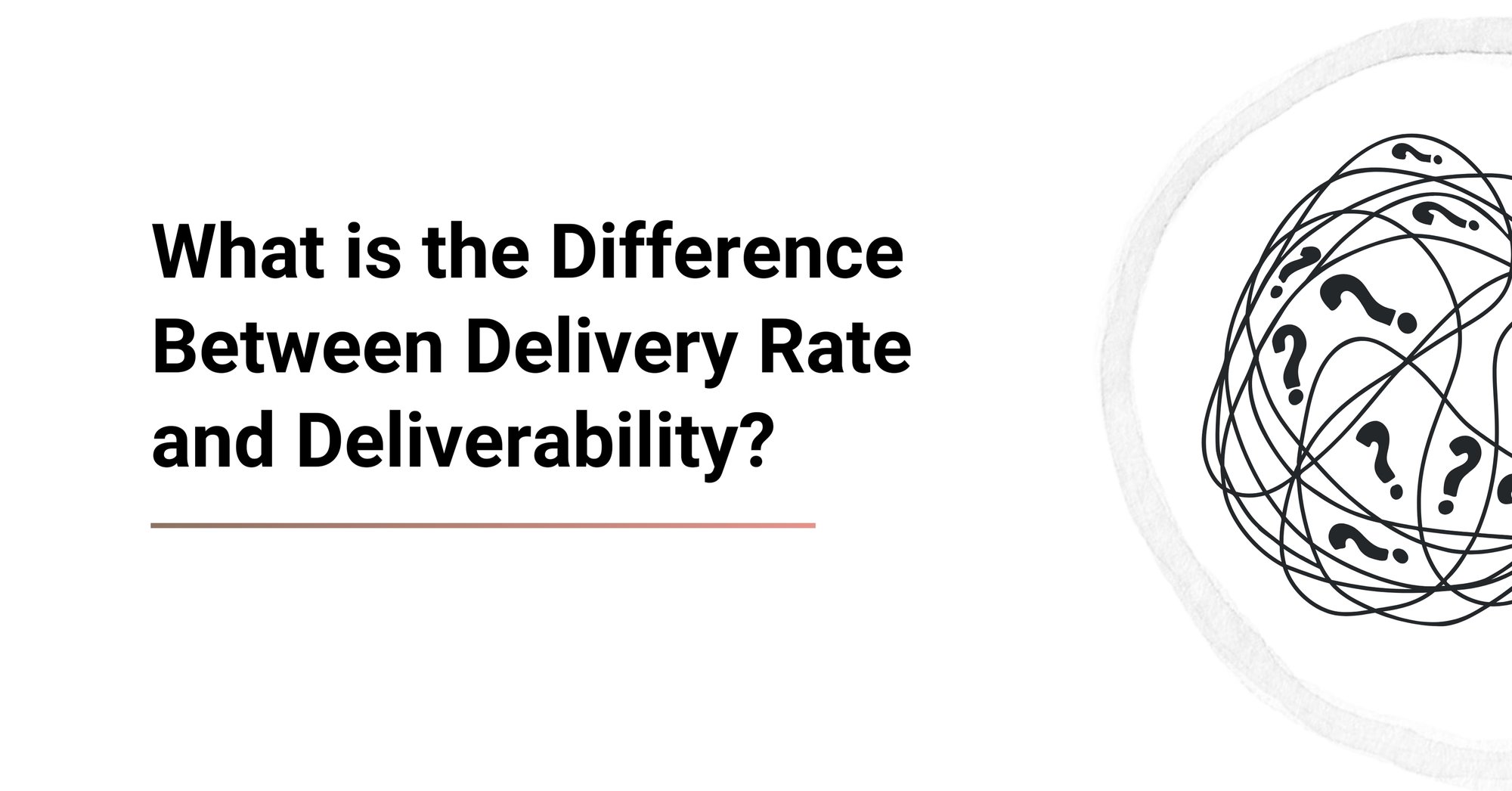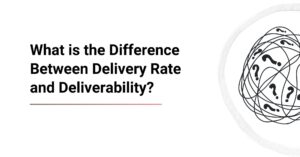Why do some of your emails reach the server but still miss the inbox? That’s where the difference between delivery rate and email deliverability comes in. Both are key metrics, but they measure different aspects of your email performance.
If your delivery rates are high but your emails aren’t reaching your audience, it might be time for an email deliverability health check. This could help make sure your messages land where they need to be—in the inbox.
Here’s a breakdown of what these terms mean and how you can improve them.
What is Email Delivery Rate?
Email delivery rate is often mistaken for deliverability, but they aren't the same thing. Your delivery rate refers to the percentage of emails that successfully reach your recipients’ mail servers. In other words, it tracks whether or not the email was “accepted” by the recipient's email service provider.
So, what impacts delivery rate?
- Bounces: If an email can’t be delivered, it’s considered a bounce. Bounces—especially soft bounces caused by full inboxes or temporary server issues—can hurt your delivery rate if not addressed.
- Technical setup: If your domain's DNS settings aren't configured correctly (e.g., you lack proper SPF or DKIM authentication), your emails could be rejected by servers.
Why is it important?
Delivery rate is a foundational metric—it tells you if your emails are getting through to recipients' servers. But just because an email lands on the server doesn't mean it ends up in the inbox. That’s where deliverability comes in.
List hygiene: A clean and updated email list also helps boost your delivery rate. By removing inactive or incorrect addresses, you reduce bounce rates and increase the chances of your emails reaching valid recipients.
ISP reputation: Internet Service Providers (ISPs) track the sender's history. If you’ve had issues with bounces or spam complaints in the past, it can affect your delivery rate moving forward.
Quick Example:
You send 1,000 emails, and 950 are successfully delivered to your recipients' servers. Your delivery rate is 95%. This means 50 emails bounced or were rejected. But of those 950 delivered emails, how many actually landed in the inbox? That’s where we transition to the next key concept: deliverability.
What is Email Deliverability?
While delivery rate tracks whether your emails reached the server, email deliverability tracks what happens after. It refers to whether the email actually made it to the inbox, rather than being filtered into spam or a promotions tab.
Email deliverability involves more complexity than delivery rate and depends on several factors. It’s not enough for the server to accept your email—you need to make sure it actually reaches the primary inbox, where it belongs. Your email’s success depends on a series of checks, both automated and based on user behavior, that determine its final destination.
Here are some key elements that impact deliverability:
- Sender reputation: Your domain builds a reputation based on your sending behavior. When you send too many emails to inactive accounts or trigger frequent spam complaints, you damage that reputation. Email providers notice this behavior and may filter your emails out before they reach the inbox.
- Content: Email messages that contain certain keywords or phrases that trigger spam filters (like “buy now” or “limited-time offer”) may never make it to your recipients’ primary inbox. Reputable email service providers actively scan content and sender behavior to detect spammy or unsolicited messages before they hit the inbox.
- Engagement: If recipients frequently open, click, and engage with your emails, email providers are more likely to deliver your messages to the inbox. Strong inbox engagement—like frequent opens, clicks, and replies—tells email providers your messages are valuable, boosting your inbox placement.
- Authentication Protocols: Without proper authentication, like SPF, DKIM, or DMARC, email providers might flag your emails as suspicious. These protocols act like security badges, verifying your identity so that email servers can safely route your incoming emails to the correct folder.

Why Email Deliverability Matters for Your Business
Why should email deliverability matter to your business? In reality, even the most perfectly crafted email campaigns won’t have an impact if they don’t land in subscribers inboxes. Without strong deliverability, your efforts could be falling short and your campaigns won’t reach their full potential.
Now that we’ve covered what deliverability means, let’s explore why it’s so important for your email marketing success.
- Higher Engagement
Imagine spending hours crafting the perfect email—great subject line, compelling content, attractive design—but your message lands in spam folders. If your email isn’t being seen, all that effort is wasted. With better deliverability, your email reaches the inbox, meaning more opens, clicks, and conversions.
- Improved ROI
When your emails land in the right place, your chances of engaging potential customers increase. This leads to better conversion rates and a higher return on your email marketing investment. Essentially, great deliverability means you’re maximizing the value of your email list and the effectiveness of your campaigns.
- Increased Trust and Sender Reputation
Deliverability is directly tied to your domain's sender reputation. If your emails consistently land in inboxes and get positive engagement (opens, clicks, etc.), your reputation with email service providers (ESPs) will improve. A stronger reputation means fewer emails end up in spam and more end up in front of your audience.
Key Differences Between Delivery Rate and Deliverability
Understanding the difference between delivery rate and deliverability is vital to running successful email campaigns. Below is a simple comparison to clarify these concepts:
| Metric | Delivery Rate | Deliverability |
|---|---|---|
| Deffinition | Percentage of emails accepted by recipients’ servers | Whether emails land in the inbox or are filtered out |
| Focus | Technical success | Effectiveness of inbox placement |
| Influencing Factors | Bounce rates, invalid emails, server issues | Sender reputation, content, engagement |
| Goal | Reach the server | Reach the inbox |
Key takeaway:
A high delivery rate doesn’t necessarily mean your emails are being seen. You need both a high delivery rate and excellent deliverability to achieve optimal results.
How to Improve Email Deliverability
Now that you understand the importance of deliverability, let’s discuss some practical steps to improve it.
- Maintain a clean email list
- Use email authentication protocols (SPF, DKIM, DMARC)
- Optimize email content to avoid spam triggers
- Segment your audience for better engagement
- Monitor engagement metrics regularly
Let’s break these down one by one:
1. Maintain a Clean Email List
Start by keeping your mailing list clean. Regularly remove inactive subscribers and email addresses that bounce frequently. A cluttered list full of outdated or incorrect addresses can negatively affect both your delivery rate and your sender reputation.
2. Use Authentication Protocols
Ensure that your domain is authenticated. Implement authentication protocols like SPF (Sender Policy Framework), DKIM (DomainKeys Identified Mail), and DMARC (Domain-based Message Authentication, Reporting & Conformance). These protocols tell email servers that your emails are legitimate, significantly improving your deliverability.
3. Optimize Email Content
Avoid using spammy phrases in your subject lines and content. Think of words like "free," "buy now," or "urgent." These can trigger spam filters and send your carefully crafted emails straight to the junk folder. Instead, use clear and engaging language that resonates with your audience.
4. Segment Your Audience
Segmentation improves engagement, which in turn boosts deliverability. By segmenting your audience based on their behavior or preferences, you can send more personalized content that your recipients are likely to open and engage with. Higher engagement leads to better deliverability.
5. Monitor Engagement Metrics
Engagement metrics, such as open rates and click-through rates, are key to understanding how your audience interacts with your emails. If your engagement starts to decline, it's a warning sign that your deliverability might be slipping. Regularly track these metrics to catch any potential issues early.
Tools to Monitor Email Delivery and Deliverability
If you're not already using tools to monitor your delivery and deliverability, now is the time to start. Here are a few options to consider:
1. Litmus
Litmus offers a wide range of email testing tools, including inbox placement checks. It helps you understand where your emails are landing and provides suggestions on how to improve deliverability.
2. GlockApps
This tool is excellent for identifying potential deliverability issues. It offers real-time tracking and diagnostics, so you can see exactly where your emails are being delivered (or filtered).
3. Mailgun
Mailgun gives you detailed reports on email performance, including delivery rates, bounces, and inbox placement. It’s a great tool to ensure your emails are hitting the mark.
Key Takeaway
Understanding the difference between delivery rate and email deliverability is essential for improving your email marketing strategy. While delivery rate focuses on getting your emails to the recipient's server, deliverability ensures they land in the right place—the inbox.
To improve both, you need to maintain a clean list, use proper authentication protocols, and consistently monitor your engagement metrics. By following these best practices, you’ll see higher engagement, improved ROI, and better trust in your sender reputation.
At Email Industries, we specialize in optimizing email deliverability to help you connect with your audience effectively. Our team offers tailored solutions and expert guidance to ensure your emails reach the inbox where they belong.
Want to ensure your emails reach your audience? Book a free email deliverability health check today and start improving your campaign performance with our support.
Book a free email deliverability health check today and start improving your campaign performance.








